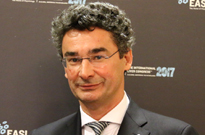
编者按:第52届欧洲肝脏研究学会(EASL)年会召开期间,《国际肝病》前方记者有幸邀请到EASL现任秘书长、法国巴黎第七大学Laurent Castera教授为我们介绍本届会议盛况、大会亮点、热点话题,分享备受关注的丙型肝炎的最新进展与研究趋势。让我们跟随Castera教授走进这次不同凡响的学术之旅。
EASL2017,不一样的学术盛宴
“ I am really enjoying this meeting. This is an outstanding meeting.”
据Castera教授介绍,来自127个国家的逾9500名代表注册参会,大会收录2500余篇摘要。相比于EASL2016,EASL理事会再次制定出了精彩的学术计划。大会前两日,继续教育课程系列报告颇受欢迎,聚焦常见肝病的多学科管理,包括非酒精性脂肪性肝病(NAFLD)、酒精性肝病、肝细胞肝癌(HCC)、胆汁淤积性肝病及肝硬化并发症。同期,大会特别设置了基础科学课程,关注再生医学。
大会亮点与热点话题
“As highlights of this meeting, we have two State-of-the-Art Lectures.”
两场State-of-the-Art演讲是本届会议的“出彩之处”,不得不看:意大利Vincenzo Mazzaferro教授将在“Jean-Pierre Benhamou Clinical State-of-the-Art”专题中介绍HCC的肝移植适应证(21日);瑞士Mike Hall教授将在“Karl Wilhelm von Kupffer Basic State-of-the-Art” 专题中介绍癌症治疗的细胞生长调控(22日)。
此外,大会还组织了联合论坛,如EASL-APASL联合论坛(22日),分享HCC的东西方观点;设置融合肝脏病学专题,聚焦丙型肝炎(22日)。
在整个学术议程中,可以发现临床观念正因丙型肝炎的治愈而改变,值得一看。本届会议在话题设置方面更加多样化,不仅囊括了NAFLD、HCC和乙型肝炎领域的众多热点话题,而且覆盖了新兴话题如胆汁淤积性肝病。
全球热议:丙型肝炎的进展与挑战
“The focus is moving towards the management of post-SVR complications including occurrence and recurrence of HCC after DAAs.”
现今,丙型肝炎治疗可以获得非常高的持续病毒学应答(SVR)率/治愈率(超过90%),大多数合并肝硬化患者可实现治愈。Castera教授认为,获得SVR后的合并症的管理正成为新的研究焦点,包括接受直接抗病毒药物(DAA)治疗后的HCC发生和复发。针对这一尚存争议的话题,各国学者在相应专题会议中进行了探讨。此外,大会也聚焦特殊亚组人群,如基因3型肝硬化无应答患者、肝移植等待名单上的患者,以及合并肾脏疾病的患者。关于治疗可及性,大会给予了高度重视。
英文原文:
I am really enjoying this meeting. This is an outstanding meeting. We have more than 9500 attendees from 127 countries with over 2500 abstracts. The EASL Governing Board has again set up an outstanding scientific program. At the start of the meeting, we ran the Post-graduate Course on the multidisciplinary approach to common liver diseases, including NAFLD, alcohol, HCC, cholestatic disease and complications of cirrhosis. The Post-graduate Course was very well attended. In parallel, we ran the Basic Science Course on regenerative medicine.
As highlights of this meeting, we have two State-of-the-Art Lectures. One is the Jean-Pierre Benhamou Clinical State-of-the-Art to be given by Vincenzo Mazzaferro (Italy) on the indications for transplantation in HCC. The Karl Wilhelm von Kupffer Basic State-of-the-Art will be given by Mike Hall from Switzerland on cell growth control in cancer therapy. Additionally, we conduct Joint Sessions. We have a Joint Session with APASL on HCC with perspectives from the East and the West. We also have a Fusion Session focusing on hepatitis C. In the Scientific Program, it is interesting to see how the landscape is changing with the cure for hepatitis C. The meeting is showing greater variety in terms of the range of topics. Of course, there is a lot of interest in NAFLD and HCC, also in hepatitis B, but there are new emerging topics such as cholestatic liver, for example.
Today with hepatitis C treatment, we can achieve very high sustained virus response rates/cure rates above 90%. We can cure most patients with cirrhosis. The focus is moving towards the management of post-SVR complications including occurrence and recurrence of HCC after DAAs. This is still a controversial topic and we witnessed a very interesting session today at the meeting on this topic. We are also focusing on specific subgroups like cirrhotic genotype 3 patients who are non-responders, patients who are on the waiting list for liver transplantation, and patients with kidney disease. Another important aspect is access to treatment.